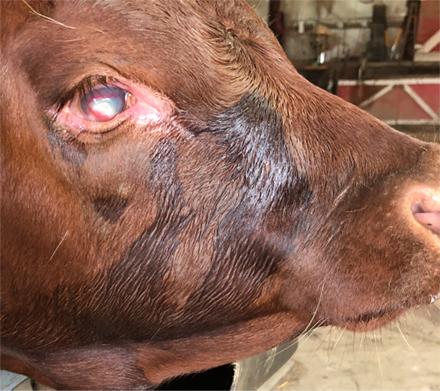Advances in Research Pave the Way for New Treatments, Diagnostics, and Vaccines

Advanced case of pinkeye. (Photo by Mike Clawson)
Scientists with the Agricultural Research Service (ARS) and their research partners have made several discoveries that may help in the fight against a painful eye disease that is ranked the country’s 3rd greatest health challenge to cattle herds: pinkeye.
Pinkeye is a highly contagious disease that has infected 50% of the nation’s herds. Within those herds, about 9% of calves have pinkeye. Fully one-eighth of cattle producers name it as their most important problem.
According to Mike Clawson, molecular biologist at the ARS Animal Health Genomics (AHG) research unit of the U.S. Meat Animal Research Center in Clay Center, NE, pinkeye (infectious bovine keratoconjunctivitis), is an infection that is caused by a pathogen that sticks to the surface of the eye. That pathogen is often Moraxella bovis, which secretes a toxin that damages and kills ocular (eye) tissues, and results in painful ulcers. Left untreated, pinkeye can cause blindness and other long-term problems.
Surprisingly, while examining M. bovis, Clawson’s team discovered that there are actually two variants of the bacteria that cause pinkeye. This knowledge could help scientists develop preventive measures and treatments to protect the American cattle herd. The research team included Emily Wynn, microbiologist at AHG, and two partners from the University of Nebraska-Lincoln, veterinary microbiologist Dustin Loy and diagnostic pathologist Matt Hille.
The research team found the second variant as part of their collaboration in connection with a project looking into respiratory diseases of cattle and other ruminants (hoofed mammals with a specialized digestive process). Flies are the primary vector of pinkeye, but the disease can be spread by contact with tears and mucus of infected animals.
Clawson explained that the bacteria can live in the host’s eye or nose without causing problems, but given the opportunity, can start secreting toxin and cause pinkeye. His team wants to identify the genomic factors that make M. bovis an opportunistic pathogen.
The study shows that there are multiple genetic differences between the two variants, and that they may not contribute equally to causing pinkeye. “If true, we could target the one disease-dominant variant with a vaccine and not the other, or both, if necessary,” Clawson said. “This level of precision targeting should lead to better outcomes for animal health.”
According to Wynn, the differences between the genotypes are substantial. "For example, M. bovis has a toxin, called hemolysin toxin, that it uses to damage the eye. We found that the two genotypes have different versions of the toxin. This difference, and others identified among a collection of the two M. bovis variants, could mean that there are variations in their ability to cause disease.”
Hille explained that “Through [genetic] sequencing, we increase our understanding of how M. bovis works. Thus, the pathogen is starting to ‘show its hand,’ and provide targets or pathways that we can use to enhance diagnostics and develop disease prevention strategies.”
While discovering the second bacterial variant is important, there are also many other factors to consider when dealing with the disease. Loy described pinkeye as a classic disease complex that includes the pathogen, the host, and the environment. For example, ultraviolet light can damage the eye (one potential reason white-faced cattle are more susceptible) and environments with lots of dust or tall grass may cause microabrasions to the eye. There may also be other pathogens involved in addition to M. bovis that contribute to the severity of pinkeye.
Vaccines for pinkeye are not always effective and treatment often includes using antibiotics. Treatments can be costly, sometimes difficult to administer, and not always effective.
The pain of pinkeye causes cattle to eat less, reducing their weight by as much 30-40 pounds. This loss, in addition to treatment, costs the U.S. cattle industry about $300 million per year.
“With better diagnostics, treatments, and interventions we can provide veterinarians and producers with more information on what is causing the problem in their herd and how to deal with it,” Loy said. “Long-term, effective pinkeye prevention strategies would improve animal welfare by reducing a painful disease that causes blindness and enhance production by weaning healthier and heavier calves.” – by Scott Elliott, ARS Office of Communications
Also in our series on cattle:

